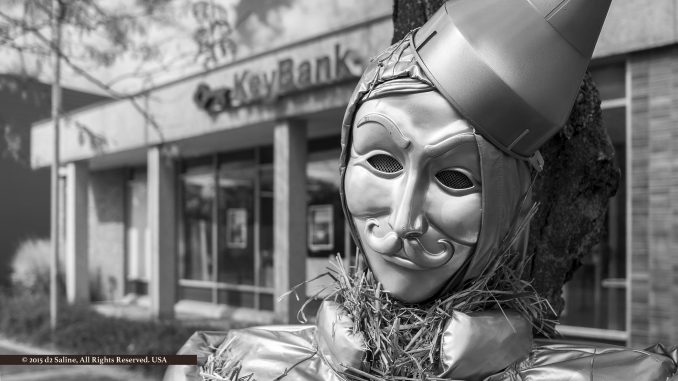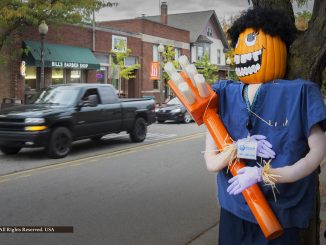
With the growing sophistication of Instagram and iPhone filters, photographers of all skill levels are chosing to post more of their images in black and white (B&W) on social media.
Add to that the upcoming sixth annual Saline Scarecrow Contest scheduled to run next month and you have a past entry that nicely supports this discussion. Here, it’s The Tin Woodman from The Wonderful Wizard of Oz by L Frank Baum and WW Denslow, 1899. [1,2]
Popular culture better remembers the 1938 Metro-Goldwyn-Mayer motion picture which famously mixed black and white sequences with color at a time when the latter was virtually unheard of. This image pays homage to that (if you’ll forgive that The Tin Man from MGM appeared exclusively Technicolor). [3]
Silver tones obviously emphasize the “tin” aspect of The Tin Man. It provides for a more artistic feel, which is an important aspect of the downtown Saline image. Some photography experts have even argued that any photograph in which “color plays no importance for the strength of the image” should, by default, be rendered in black and white. [4,5]
Key elements to look for in making your B&W versus color decisions are form, texture, and contrast. Lighting — whether natural or enhanced — will affect all of these. Sometimes the same image could go either way, with available light as determining factor. [6,7]
Study images that you might think would have benefited from having been released in black and white, but were not. Assuming that was a conscious decision made by the artist, ask yourself what likely instructed his or her thinking. [8]
One of the nice things about the Instagram and iPhone approaches mentioned above is that B&W rendering is applied after your image is captured, “post-processing.” There are cameras that allow users to “shoot in black and white,” including very important cameras such as the Fujifilm X100F and Ricoh GR II; the sensor in the Leica M Monochrom is not only optimized for black and white, it’s incapable of recording color.
Fine places to start, but ultimately unsatisfying. Even in the days of film photography, professionals didn’t simply load a roll of 35mm Tri-X and head off snapping. They got their best black and white images by putting filters of differing colors between their camera lenses and subject matter.
For a deep dive into some of the more technical considerations, check out “12 Ways to Make a Black & White Photo” by Brian Auer from a few years back. [9]
As to The Tin Man in front of KeyBank at the Saline four corners, this entry from The Dillons came in third by popular vote in the 2015 Borer Family Chiropractic competition. No word yet if he’ll be making another run here in 2017. [10]
If you get any images of your own to share — B&W or color — do consider sharing them on social media.
References
Photographed on October 8, 2015 4:10pm using Leica X2 camera with 24mm Elmarit f/2.8 lens, set to f/4 at 1/800-second and ISO 100 (hand-held).
- “Saline Scarecrow Contest” Borer Family Chiropractic.
- The Wonderful Wizard of Oz (Library of Congress) L Frank Baum (1899).
- “The Wizard of Oz (1938)” IMDb.
- “The Pros and Cons of Black and White Versus Color for Street and Travel Photography” Andrew S Gibson, Digital Photography School.
- “Determining If A Photo Should Be Left In Color Or Converted To Black And White” Pratik Naik (December 4, 2013) Fstoppers.
- “Mastering the Art of Black and White Photography” Andrew Gibson (September 10, 2009) Envato Tuts+.
- “5 Black and White Photography Tips” Darren Rowse, Digital Photography School.
- “‘Timing’ Is an Important Factor for Capturing Historic Photographs” Dell Deaton (January 17, 2014) Saline Journal.
- “12 Ways to Make a Black & White Photo” Brian Auer (March 3, 2007) Epic Edits.
- “2015 Winners!!!” Borer Family Chiropractic.



